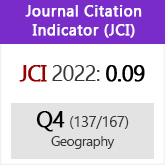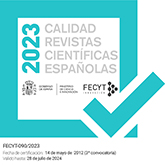Transiciones necesarias hacia entornos metropolitanos resilientes a través de la biorregión
Keywords:
territorial risks, patrimonial system, metabolic equilibrium, environmental justice, urban-regional planning, resilienceAbstract
Climate change as well as the loss of ecosystems and biodiversity are among the main consequences of the socio-ecological imbalance that has been occurring in the Anthropocene. Its harmful influences are evident at the global level, among others, in the loss of ecosystem services and in the deterioration of human health. Faced with a dramatic scenario that threatens many of the metropolises that were previously perceived as safe spaces with little vulnerability, a paradigm shift in territorial planning based on resilient strategies is advocated.
Based on the concept of bioregion, we are committed to the development of comprehensive proposals that foster the creation of a space of vital security in which the systems established in the metropolises can stimulate a necessary eco-social transition. Through the standardized proposal of bioregional areas, resilience principles based on social welfare, environmental justice, metabolic balance, and regeneration of their heritage system must prevail.
Downloads
References
Ahern, M., Kovats, R. S., Wilkinson, P., Few, R., & Matthies, F. (2005). Global health impacts of floods: Epidemiologic evidence. Epidemiologic Reviews, 27, 36-46. https://doi.org/10.1093/epirev/mxi004 PMid:15958425
Borja Barrera, F., & Montes del Olmo, C. (2008). La gestión ecosistémica como herramienta territorial para la toma de decisiones. Ecorregiones e integración funcional de carreteras y espacios naturales protegidos. In II Congreso Nacional de Medio Ambiente en Carreteras.
Burnett, R., Chen, H., Szyszkowicz, M., Fann, N., Hubbell, B., Pope, C. A., Apte, J. S., Brauer, M., Cohen, A., Weichenthal, S., Coggins, J., Di, Q., Brunekreef, B., Frostad, J., Lim, S. S., Kan, H., Walker, K. D., Thurston, G. D., Hayes, R. B., … Spadaro, J. V. (2018). Global estimates of mortality associated with long-term exposure to outdoor fine particulate matter. Proceedings of the National Academy of Sciences, 115(38), 9592-9597. https://doi.org/10.1073/pnas.1803222115 PMid:30181279 PMCid:PMC6156628
Cardona, R., Bustos, G., & Martin Fiorino, V. (2011). Circadiana en el paisaje urbano desde la epistemología compleja. Orbis. Revista Científica Electrónica de Ciencias Humanas, 18(7), 82-115.
Consejo Noctuno. (2015). Un habitar más fuerte que la metrópoli. Un habitar más fuerte que la metrópoli. Consejo Nocturno, Primera Edición. ISBN: 978-84-15862-63-5.
Cook, I. R., & Swyngedouw, E. (2012). Cities, Social Cohesion and the Environment: Towards a Future Research Agenda. Urban Studies, 49(9), 1959-1979. https://doi.org/10.1177/0042098012444887
CRED y UNDRR. (2020). The human cost of disasters: an overview of the last 20 years 2000-2019. Centre for Research on the Epidemiology of Disasters (CRED) - United Nations Office for Disaster Risk Reduction (UNDRR), Lovaina / Ginebra.
Credit Suisse Research Institute. (2019). Global wealth report 2019 (Issue October).
Declaración Vasca. (2016). Declaración Vasca: Nueva Hoja de Ruta Para Ciudades y Pueblos Europeos, Creando Municipios Productivos, Sostenibles y Resilientes para una Europa Habitable e Inclusiva.
Díez Medina, C., & Monclús, J. (2018). Urban Visions. In C. Díez Medina & J. Monclús (Eds.), Urban Visions: From Planning Culture to Landscape Urbanism (Issue July). Springer International Publishing. https://doi.org/10.1007/978-3-319-59047-9
Diffenbaugh, N. S., & Burke, M. (2019). Global warming has increased global economic inequality. Proceedings of the National Academy of Sciences, 116(20), 9808-9813. https://doi.org/10.1073/pnas.1816020116 PMid:31010922 PMCid:PMC6525504
Du, W.; FitzGerald, G.J.; Clark, M.; Hou, X. Y. . (2011). Health impacts of floods. Prehospital and Disaster Medicine, 26(2), 137. https://doi.org/10.1017/S1049023X11000148 PMid:21888736
Fariña Tojo, J. (2015). Cambiar el modelo urbano. Ciudades, 18(1), 69-79. https://doi.org/10.24197/ciudades.18.2015.69-79
Felber, C. (2015). Change Everything: Creating an Economy for the Common Good. CPI Group.
Fernández-Reyes, R. (2016). El Acuerdo de París y el cambio transformacional. Papeles de Relaciones Ecosociales y Cambio Global, 132, 101-114.
Folke, C., Carpenter, S. R., Walker, B., Scheffer, M., Chapin, T., & Rockstrom., J. (2010). Resilience thinking: integrating resilience, adaptability and transformability. Ecology and Society 15(4): Nature Nanotechnology, 15(4), 20. https://www.jstor.org/stable/26268226 https://doi.org/10.5751/ES-03610-150420
Gallardo Ramírez, C. (2019). Método de evaluación para la regeneración integrada del espacio turístico litoral: la costa del sol occidental.
García Jiménez, R. (2014). Teoría general de sistemas y complejidad. Contribuciones a Las Ciencias Sociales, Servicios Académicos Intercontinentales SL, issue 2014-02, February.
García García, M. (2016). Desmontando la paradoja de la sostenibilidad. Ambienta 116, 4-22.
Georgescu-Roegen, N. (1971). The Entropy Law and the Economic Process. Cambridge, MA and London, England: Harvard University Press, 1971. https://doi.org/10.4159/harvard.9780674281653
Glaser, M., Krause, G., Ratter, B., & Welp, M. (2008). Human/Nature Interaction in the Anthropocene Potential of Social-Ecological Systems Analysis. GAIA - Ecological Perspectives for Science and Society, 17(1), 77-80. https://doi.org/10.14512/gaia.17.1.18
Holland, J. H. (1996). Hidden order: how adaptation builds complexity. Addison Wesley Longman Publishing Co., Inc. Basic Books.
IPCC. (2021). Climate Change 2021: The Physical Science Basis. Contribution of Working Group I to the Sixth Assessment Report of the Intergovernmental Panel on Climate Change [Masson-Delmotte, V., P. Zhai, A. Pirani, S.L. Connors, C. Péan, S. Berger, N. Caud, Y. Chen, L. Goldfarb, M.I. Gomis, M. Huang, K. Leitzell, E. Lonnoy, J.B.R. Matthews, T.K. Maycock, T. Waterfield, O. Yelekçi, R. Yu, and B. Zhou (eds.)]. Cambridge University Press, Cambridge, United Kingdom and New York, NY, USA, 2391 pp.
Jameson, F. (1991). Postmodernism, or, the cultural logic of Late Capitalism. Duke University Press. https://doi.org/10.1215/9780822378419 PMCid:PMC1886263
Jiménez Herrero, L. M. (2016). Hacia ciudades y territorios inteligentes, resilientes y sostenibles. Gestión y Gobernanza para la gran transición urbana. Asociación para la Sostenibilidad y el Progreso de las Sociedades (ASYPS).
Koolhaas, R. (1995). Whatever Happened to Urbanism? Design Quarterly, 164, 28. https://doi.org/10.2307/4091351
Laguna Sánchez, G. A., Marcelín Jiménez, R., Patrick Encina, G. A., & Vázquez Hernández, G. (2016). Complejidad y Sistemas Complejos: Un aceracimiento multidmensional. CopIt-arXives y EditoraC3.
Lelieveld, J., Pozzer, A., Pöschl, U., Fnais, M., Haines, A., & Münzel, T. (2020). Loss of life expectancy from air pollution compared to other risk factors: a worldwide perspective. Cardiovascular Research. https://doi.org/10.1093/cvr/cvaa025
Millennium Ecosystem Assessment. (2005). Ecosystems and Human Well-being. Synthesis. Island Press.
Montes del Olmo, C. (2007). Del desarrollo sostenible a los servicios de los ecosistemas. Ecosistemas: Revista Científica y Técnica de Ecología y Medio Ambiente, 16(3), 1-3.
Montes del Olmo, C., Borja Barrera, F., Bravo, M. A., & Moreira, J. M. (1998). Reconocimiento Biofísico de Espacios Naturales Protegidos. In Doñana: Una Aproximación Ecosistémica. Consejería de Medio Ambiente. Junta de Andalucía.
Moore, J. W. (2015). Capitalism in the Web of Life: Ecology and the Accumulation of Capital, Londres / Nueva York, Verso.
Moore, M., Gould, P., & Keary, B. S. (2003). Global urbanization and impact on health. International Journal of Hygiene and Environmental Health, 206(4-5), 269-278. https://doi.org/10.1078/1438-4639-00223 PMid:12971682
Morin, E. (1990). Introduction à la pensée complexe. Editions du Seuil.
Mussetta, P. (2020). 634. La adaptación como respuesta al cambio climático. Notas acerca de las contracaras de un paradigma dominante. Scripta Nova, 24. https://doi.org/10.1344/sn2020.24.27841
O'Neill, D. W., Fanning, A. L., Lamb, W. F., & Steinberger, J. K. (2018). A good life for all within planetary boundaries. Nature Sustainability, 1(2), 88-95. https://doi.org/10.1038/s41893-018-0021-4
Paredes Castillo, D. (2016). Enfoque ecosistémico y corredores de conservación de la biodiversidad.
Prats, F., Cuchí, A., & Oscariz, J. (2017). Ante el antropoceno. Reflexiones sobre la cuestión biorregional en el País Vasco. Dpto. de Medio Ambiente, Planificación Territorial y Vivienda. Gobierno Vasco. https://bit.ly/3oKnklr.
Raworth, K. (2014). A safe and just space for Humanity: Can we live within the doughnut? Oxfam GB. https://doi.org/10.5822/978-1-61091-458-1_3
Raworth, K. (2017). Doughnut Economics: 7 Ways to Think Like a 21st Century Economist. Chelsea Green Publishing.
Requejo Liberal, Juan (2022). Un reto histórico: el reacoplamiento de la ciudad y el territorio como sistemas vivos, Hábitat y Sociedad, 15, 133-160. https://doi.org/10.12795/HabitatySociedad.2022.i15.07
Salazar-Galán, S., Mascort-Albea, E. J., & Sánchez-Fuentes, D. (2022). Redefinición territorial pos COVID-19: resiliencia frente a riesgos y desequilibrios en los modelos urbano-rurales. EURE. Revista Latinoamericana de Estudios Urbano-Regionales, 48(143). https://doi.org/10.7764/EURE.48.143.16
UNDP. (2022). Human Development Report 2021/2022: Uncertain times, unsettled lives: Shaping our future in a transforming world. United Nations Development Programme, New York.
UNEP. (2022). Emissions Gap Report 2022: The Closing Window - Climate crisis calls for rapid transformation of societies. United Nations Environment Programme. Nairobi. https://www.unep.org/emissions-gap-report-2022.
Walker, B., & Salt, D. (2006). Resilience Thinking: Sustaining Ecosystems and People in a Changing World.
WMO. (2023). State of the Global Climate 2022. World Meteorological Organisation, WMO-No. 1316, Ginebra.
Published
How to Cite
Issue
Section
License
Copyright (c) 2023 Consejo Superior de Investigaciones Científicas (CSIC)

This work is licensed under a Creative Commons Attribution 4.0 International License.
© CSIC. Manuscripts published in both the printed and online versions of this Journal are the property of Consejo Superior de Investigaciones Científicas, and quoting this source is a requirement for any partial or full reproduction.All contents of this electronic edition, except where otherwise noted, are distributed under a “Creative Commons Attribution 4.0 International” (CC BY 4.0) License. You may read here the basic information and the legal text of the license. The indication of the CC BY 4.0 License must be expressly stated in this way when necessary.
Self-archiving in repositories, personal webpages or similar, of any version other than the published by the Editor, is not allowed.












